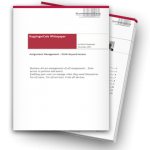There are undeniably enormous benefits associated with digitizing medical records. Health care organizations have become increasingly reliant on technology to improve patient care, streamline operations and reduce costs — but not without Protected health information (PHI) risks. Because of course you are subject to stringent HIPAA privacy statutes and HIPAA HITECH information technology audit requirements, health care organizations are mandated to maintain HIPAA HITECH compliance around the security of private patient data. To successfully digitize, migrate and manage the confidentiality of these records, it’s imperative to leverage identity management and access management best practices before getting started.
Automating identity management user provisioning and access management ensures that only authorized personnel are allowed to access patient records. Just as importantly, it also certifies that they’re only allowed to view what’s necessary to do their jobs. Tighter data security isn’t the only benefit to access provisioning workflow — automated user provisioning protocols can certainly improve administrative efficiency, enforce role-based system access, simplify audits and improve IT service levels.
How do you create the rules that govern identity management and access provisioning? Start with role-based system access. For instance, if one nursing shift leader has a specified set of access rights, all other shift leaders should have the same access. This eliminates guesswork and ambiguity and ensures that access is based strictly on a user’s role in the organization. If user roles shift, the system automatically updates permissions based on the current position. Software is available to help mine these roles efficiently so you understand common entitlements across roles as well as inappropriate access that may exist for certain users.
Automated access provisioning also provides a centralized repository for a clean and clear identity IT audit trail. With the right tools in place, user access certification and verification audits that used to take days can now be completed within hours without taxing IT staff. In an environment where HIPAA PHI compliance audits are stringent and frequent, simplified access certifications save approver aggravation and valuable time thus allowing decision-makers to focus on more important health care-related activities.
Best of all, you can automate HIPAA PHI compliance. To achieve this capability you need to select and implement a modular, scalable compliance software solution pre-loaded with business rules and real-time reporting that addresses HIPAA statutes, which helps ensure HIPAA HITECH compliance.
A data security breach is problematic for any organization, but for a health care organization, the repercussions can be devastating. The organization will not only lose the trust of the patient and physician base but also find itself in serious legal and regulatory hot water. The best way to avoid this scenario is to proactively automate identity and access management provisioning solutions before going digital. It will save you time and money — and, more importantly, protect you from legal exposure and regulatory retribution on the back end.
Watch Gwinnett Medical Center talk about automating HIPAA HITECH compliance for the user account provisioning of systems, equipment and healthcare facilities through IT automation and self-service administration.
 Get the Free KuppingerCole Identity Management Analyst White Paper
Get the Free KuppingerCole Identity Management Analyst White Paper
Learn the role IT automation and business driven self-service administration play in creating lean operations. KuppingerCole’s Assignment Management — Think Beyond Access describes the shift in IT operations from tightly controlled identity management processes to workflow enabled administration.




